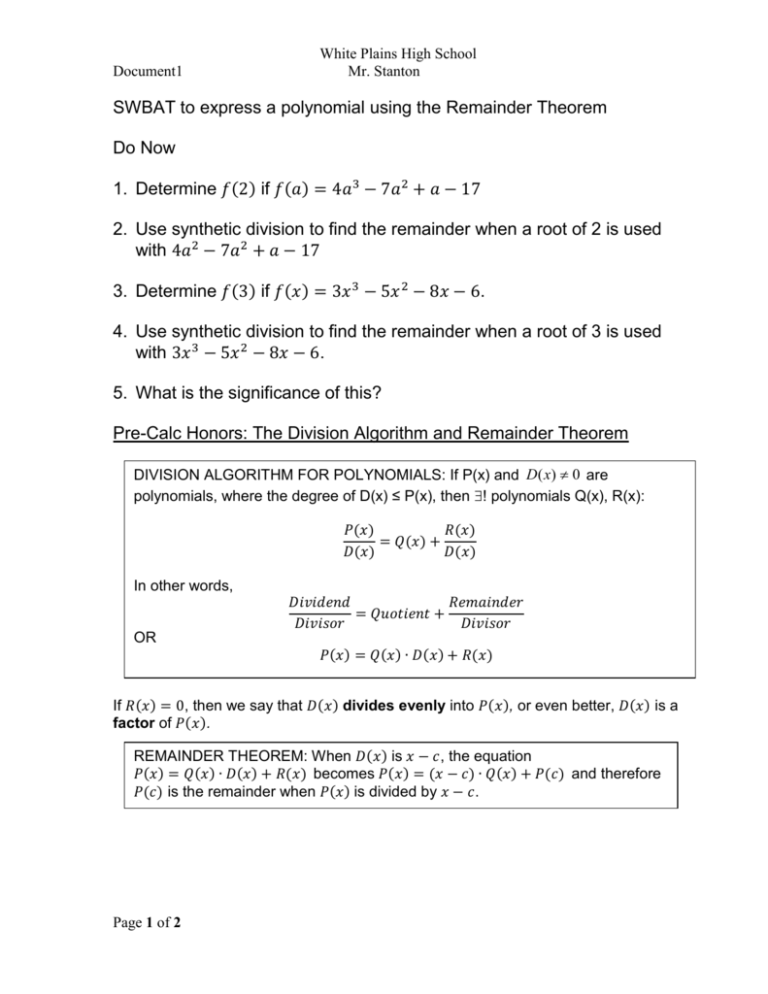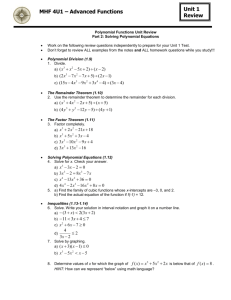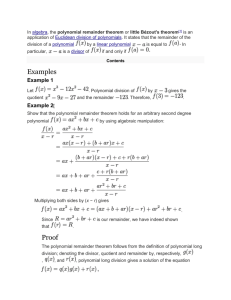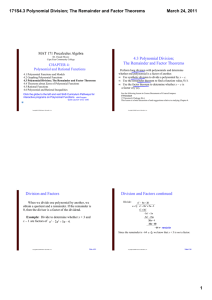6.5 The Remainder Theorem - White Plains Public Schools
advertisement

Document1 White Plains High School Mr. Stanton SWBAT to express a polynomial using the Remainder Theorem Do Now 1. Determine 𝑓(2) if 𝑓(𝑎) = 4𝑎3 − 7𝑎2 + 𝑎 − 17 2. Use synthetic division to find the remainder when a root of 2 is used with 4𝑎2 − 7𝑎2 + 𝑎 − 17 3. Determine 𝑓(3) if 𝑓(𝑥) = 3𝑥 3 − 5𝑥 2 − 8𝑥 − 6. 4. Use synthetic division to find the remainder when a root of 3 is used with 3𝑥 3 − 5𝑥 2 − 8𝑥 − 6. 5. What is the significance of this? Pre-Calc Honors: The Division Algorithm and Remainder Theorem DIVISION ALGORITHM FOR POLYNOMIALS: If P(x) and D( x) 0 are polynomials, where the degree of D(x) ≤ P(x), then ! polynomials Q(x), R(x): 𝑃(𝑥) 𝑅(𝑥) = 𝑄(𝑥) + 𝐷(𝑥) 𝐷(𝑥) In other words, OR 𝐷𝑖𝑣𝑖𝑑𝑒𝑛𝑑 𝑅𝑒𝑚𝑎𝑖𝑛𝑑𝑒𝑟 = 𝑄𝑢𝑜𝑡𝑖𝑒𝑛𝑡 + 𝐷𝑖𝑣𝑖𝑠𝑜𝑟 𝐷𝑖𝑣𝑖𝑠𝑜𝑟 𝑃(𝑥) = 𝑄(𝑥) ∙ 𝐷(𝑥) + 𝑅(𝑥) If 𝑅(𝑥) = 0, then we say that 𝐷(𝑥) divides evenly into 𝑃(𝑥), or even better, 𝐷(𝑥) is a factor of 𝑃(𝑥). REMAINDER THEOREM: When 𝐷(𝑥) is 𝑥 − 𝑐, the equation 𝑃(𝑥) = 𝑄(𝑥) ∙ 𝐷(𝑥) + 𝑅(𝑥) becomes 𝑃(𝑥) = (𝑥 − 𝑐) ∙ 𝑄(𝑥) + 𝑃(𝑐) and therefore 𝑃(𝑐) is the remainder when 𝑃(𝑥) is divided by 𝑥 − 𝑐. Page 1 of 2 Document1 Page 2 of 2 White Plains High School Mr. Stanton Document1 White Plains High School Mr. Stanton Summary on Synthetic Division Given a polynomial function P(x), explain how you would use synthetic division to… a) Divide P(x) by (x – 3) b) Determine if x = 3 is a root (solution) of polynomial P(x) c) Determine if (x – 3) is a factor of polynomial P(x) d) Determine if (2x – 3) is a factor of P(x) e) Determine P(3) f) Solve a polynomial equation given a root 𝑟 Page 3 of 2 Document1 White Plains High School Mr. Stanton In 11-16… a) Determine if the 1st polynomial is a factor of the 2nd polynomial b) Write the 2nd polynomial in the form P ( x) Q ( x) D ( x) R partial answers are in parentheses 11. 12. 13. 14. 15. 16. D( x) ( x 1); P( x) x5 x 4 x3 x 2 x 1 D( x) ( x 1); P( x) x8 x5 2 D( x) ( x 1); P( x) x10 x9 x 1 D( x) ( x 2); P( x) x8 2 x 7 x 2 D( x) ( x 2i); P( x) x3 x 2 4 x 4 D( x) ( x i); P( x) x3 x 2 x 1 (yes) (no) (yes) (yes) (yes, hint: conjugates!) (yes) 17. Determine a value k such that the 1st polynomial is a factor of the 2nd polynomial D( x) ( x 2); P( x) 2 x3 3x 2 kx k 1 Page 4 of 2 (k=3)








